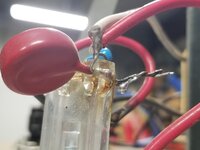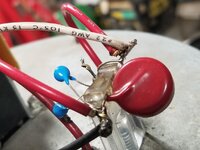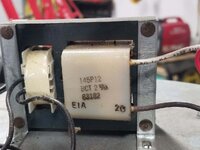Bullrunner99
Industrial
I am a novice with no electronic experience. This is a vintage SEARS BUGWACKER, MODEL 833.1432, INPUT 120V AC 60HZ 45 WATT, WITH A GRID MAX OF 5000V. The specs indicate 9 MA which I believe is milliamps. These insect zappers I believe were later known as Flowtron brand.
The two electrical grids are no longer electrified. Under the hood of the insect zapper are two ceramic capacitors. I assume them to be 5000 volts matching the product specs. I do not know the picofarad rating of the OEM capacitors? A repair handyman has determined that one capacitor failed.
I purchased Ceramic Disc Capacitors 100pf 0.1nf 101 10000V. The repair technician kept the one working OEM capacitor (5000V assumed) connected, and put two 10000V capacitors one the other side replacing the failed one. This seems imbalanced to me, since the two electrical grids on the zapper are still not electrified. The unit now has three capacitors, one OEM at 5000v and two 10000v.
Questions please:
I do not have a manual for the exact model. Attached is one for a similar, but different model.
Thank you much.
The two electrical grids are no longer electrified. Under the hood of the insect zapper are two ceramic capacitors. I assume them to be 5000 volts matching the product specs. I do not know the picofarad rating of the OEM capacitors? A repair handyman has determined that one capacitor failed.
I purchased Ceramic Disc Capacitors 100pf 0.1nf 101 10000V. The repair technician kept the one working OEM capacitor (5000V assumed) connected, and put two 10000V capacitors one the other side replacing the failed one. This seems imbalanced to me, since the two electrical grids on the zapper are still not electrified. The unit now has three capacitors, one OEM at 5000v and two 10000v.
Questions please:
- Is it acceptable to replace the two OEM capacitors with ones having voltages above 5000, such as 7000 or 10,000 volts? Sourcing 5000v capacitors has been a challenge. Does this effectively increase the voltage capability of the elecrical grids?
- How many picofarads is required on a replacement capacitor? Is a lower number better? Is 100pf acceptable, as purchased?
- Do the two replacement capacitors need to be of the same voltage?
- Might this be a Ballast or Transformer issue also?
- Any sourcing help for these components would be appreciated.
I do not have a manual for the exact model. Attached is one for a similar, but different model.
Thank you much.



